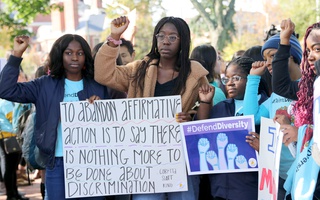{shortcode-c27ab8b3baf05da128ea1f51fd73f0623a4ccdbe}
As Harvard and Students for Fair Admissions prepare for the final stages of their ongoing lawsuit challenging the College’s consideration of race in its admissions policies, the University of North Carolina, Chapel Hill is gearing up for its own legal battle to defend its admissions processes.
The two cases — both filed Nov. 17, 2014 — pit SFFA, an anti-affirmative action group, against the schools’ race-conscious affirmative action policies. Harvard’s case, in which SFFA argues the College discriminates against Asian-American applicants, went to trial in October 2018, and both sides are now awaiting post-trial arguments and final judgement. UNC’s case, however, is just getting started. Both sides filed for summary judgement in their favor Jan. 18, asking the case’s judge to make a decision without going to trial.
The cases have much in common — a shared plaintiff, a shared effort to dismantle affirmative action, and a shared possibility of heading to the U.S. Supreme Court. But they also each harbor key distinctions that lend insight into SFFA’s legal strategy and the cases’ potential outcomes before the court.
Central to the cases’ similarity is their plaintiff: Students for Fair Admissions, and more importantly, its founder and president, Edward Blum. In addition to these two lawsuits, Blum was also behind the high-profile affirmative action case Fisher v. University of Texas, Austin, in which Abigail Fisher — a white woman — argued that the school had discriminated against her by rejecting her and admitting African-American and Latino students with similar qualifications. That case, filed in 2008, went to the Supreme Court twice — first in 2012, and then again in 2015.
In both instances the court ruled in favor of UT. In the first instance, the court argued that the use of race in college admissions met its standard of strict judicial scrutiny and that the school’s system was “precisely tailored to serve a compelling governmental interest.” The second time, the court decided that UT’s interest in educational diversity was concrete and precise enough and that it could continue to consider race in admissions if executed in the narrowest possible manner, .
Between the UT case and the ones currently at hand, Victor Goode, an associate professor at the City University of New York Law School, said he sees a larger legal strategy at play in Blum’s fight against affirmative action.
“The attack against affirmative action at this point has a very simple ideological goal in mind, and that is simply to get the case before the current Supreme Court,” he said. “Since Justice Kennedy is no longer there, I believe that they hope that they can now end affirmative action entirely.”
Mishell B. Kneeland, a former Assistant Attorney General of Texas and one of the lawyers representing University of Texas in the 2016 Fisher suit, agreed that Blum’s strategy of pushing cases to the Supreme Court has not changed. But she said his strategy has evolved as cases are decided.
“He’s doing a good job responding to the precedent that came out of the Supreme Court in Fisher and adapting to that,” Kneeland said. “I think in the UNC case they used very specific language that came out of Fisher.”
Blum wrote in an emailed statement that the Harvard and UNC cases were filed before the second Fisher ruling was handed down, but confirmed his organization aims to convince the court to overrule precedents allowing race-based affirmative action.
“While the Fisher case never asked the U.S. Supreme Court to overturn the use of race nationally, the Harvard and UNC complaints seek that outcome,” he wrote. “It is our hope that the earlier Supreme Court jurisprudence that allows racial classifications and preferences will be overturned one day.”
Despite the similarities between the cases, the nuances of their legal arguments bely the multifaceted approach Blum is taking in his attempt to eliminate race-based affirmative action. In the UNC case, SFFA is listed as a plaintiff alongside an unidentified white male. He alleges, similar to the Fisher case, that UNC discriminates against white students in its efforts to admit racial minorities.
“UNC has been basically accused of putting their finger on the scale in favor of African American and Latinx students,” Kneeland said. “It’s a different formulation than what’s been accused in the Harvard case, and so you can’t compare them the same way.”
In Harvard’s case, SFFA filed on behalf of Asian-American students, a unique “twist” in the case, according to Peter F. Lake '81, a higher education law expert at Stetson University.
The issue at at stake there, Lake said, is the question of “too much versus not enough” representation of certain racial backgrounds in college admissions.
“Asian-American students are claiming that a certain ceiling has been reached and after that it was hard to get in because of that,” he said. “In some ways that kind of claim harkens back decades to a period before the Supreme Court knocked down quotas in higher ed.”
One of the original challenges to affirmative action in the United States was whether quotas were permissible for achieving racial diversity.
Harvard and UNC also differ in that the former is private, while the latter is public. This impacts both the arguments available to them, and the likelihood that they can convince the court their practices are constitutional, Kneeland said.
“In the state cases, the state can say that it has a compelling state interest in achieving its goal, so under the Constitution you can’t discriminate against somebody but you can show a compelling state interest in something, such as diversity of the student body,” Kneeland said. “That strategy is not available to Harvard.”
Lake said the differences between the cases — which also include variations in UNC’s admissions policies compared with UT’s — are deliberate on SFFA’s part to try and convince the Supreme Court that these instances vary enough from the ones they’ve ruled on previously.
“The Harvard case certainly has that signature if they wanted it, to some extent so does UNC, because in the Fisher case, the Texas admissions process is very different,” Lake said.
—Staff Writer Camille G. Caldera can be reached at camille.caldera@thecrimson.com. Follow her on Twitter @camille_caldera.
Read more in News
Harvard Spent $600K Lobbying Congress in 2018Recommended Articles
-
 Scalia’s Death Could Affect Affirmative Action Lawsuits
Scalia’s Death Could Affect Affirmative Action Lawsuits -
 Meet the Lawyers Defending Harvard's Race-Conscious Admissions Policies
Meet the Lawyers Defending Harvard's Race-Conscious Admissions Policies -
 The Harvard Admissions Trial Starts Today. Here’s What You Need to Know.
The Harvard Admissions Trial Starts Today. Here’s What You Need to Know. -
 Wealthy Applicants Should Not Get a Leg Up in Admissions
Wealthy Applicants Should Not Get a Leg Up in Admissions -
 Harvard Admissions Trial Will Stretch Into 2019 with New Hearing, Filings
Harvard Admissions Trial Will Stretch Into 2019 with New Hearing, Filings -
 Harvard Admissions Goes to Trial
Harvard Admissions Goes to Trial













